Capresso 560Infinity Conical Burr Grinder, Brushed Silver, 8.8-Ounce, Stainless Steel
Original price was: $116.40.$97.00Current price is: $97.00.
- Commercial-grade, solid steel conical burrs with advanced cutting design
- Wide grinding range from ultrafine Turkish to French Press coarse
- Gear reduction motor grinds slow with reduced noise and little static build-up
- Large capacity: 8.8 ounce bean container and 4 ounce ground coffee container
- Easy to clean with removable upper burr
- Abs stainless finish plastic
- Color: Stainless Steel
- Dimensions: 5″L x 7.75″W x 10.5″H
Buying Guide: Capresso 560Infinity Conical Burr Grinder
Overview
The Capresso 560Infinity Conical Burr Grinder is a top-of-the-line coffee grinder designed for those who want precision grinding and a wide grinding range. With its commercial-grade construction, stainless steel finish, and large capacity, this grinder delivers exceptional performance and preserves the aroma of your favorite coffee beans.
Features
Precision Grinding
The grinder is equipped with solid steel conical burrs that offer advanced cutting design. This ensures precise and consistent grinding, allowing you to achieve the perfect grind size for your preferred brewing style.
Wide Grinding Range
From ultrafine Turkish to French Press coarse, this grinder covers every brewing preference. You have the flexibility to adjust the grind size to suit various brewing methods, including espresso, pour-over, drip coffee, or French Press.
Preserves Aroma
The gear reduction motor grinds slowly, resulting in reduced noise and minimal static build-up. This slow grinding process helps preserve the natural oils and flavors of your coffee beans, ensuring a rich and aromatic brew every time.
Large Capacity
The grinder features an 8.8 ounce bean container, allowing you to grind a significant amount of coffee in one go. The 4 ounce ground coffee container ensures you can store the freshly ground coffee without any hassle.
Easy to Clean
The upper burr is removable, providing easy access for cleaning. Keeping the grinder clean is essential for maintaining optimum performance and extending its lifespan. Regular cleaning ensures consistent and flavorful coffee each time.
Specifications
- Color: Stainless Steel
- Brand: Capresso
- Style: Grinder
- Recommended Uses: Commercial-grade
- Product Dimensions: 5″L x 7.75″W x 10.5″H
- Item Weight: 3 pounds
- Manufacturer: Capresso
- Country of Origin: China
- Item model number: 560.04
- Is Discontinued By Manufacturer: No
- Date First Available: January 22, 2009
Conclusion
The Capresso 560Infinity Conical Burr Grinder is a reliable and durable coffee grinder that allows you to enjoy the perfect cup of coffee every morning. With its precision grinding, wide grinding range, and easy maintenance, this grinder is an excellent investment for coffee enthusiasts who value quality and taste.
Price History for Capresso 560Infinity Conical Burr Grinder, Brushed Silver, 8.8-Ounce, Stainless Steel
Statistics
| Current Price | $97.00 | July 25, 2024 |
| Highest Price | $99.00 | May 17, 2024 |
| Lowest Price | $94.36 | February 5, 2024 |
Last price changes
| $97.00 | July 24, 2024 |
| $95.02 | July 12, 2024 |
| $97.00 | May 23, 2024 |
| $96.00 | May 20, 2024 |
| $99.00 | May 17, 2024 |
Specification: Capresso 560Infinity Conical Burr Grinder, Brushed Silver, 8.8-Ounce, Stainless Steel
|
8257 reviews for Capresso 560Infinity Conical Burr Grinder, Brushed Silver, 8.8-Ounce, Stainless Steel
Only logged in customers who have purchased this product may leave a review.

Original price was: $116.40.$97.00Current price is: $97.00.
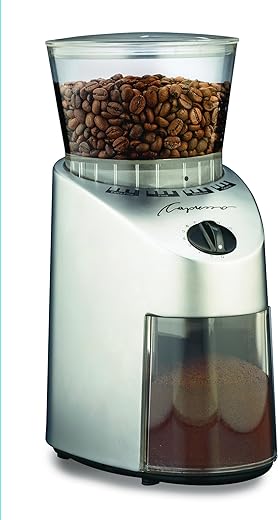
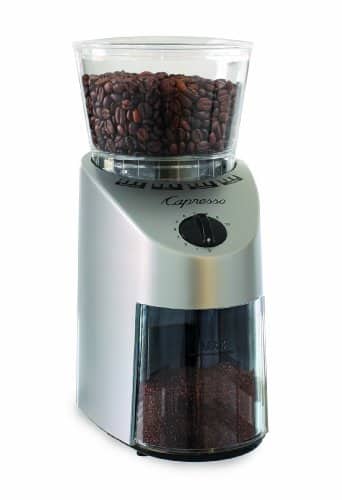



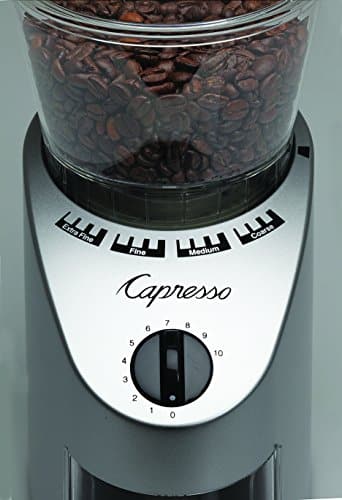
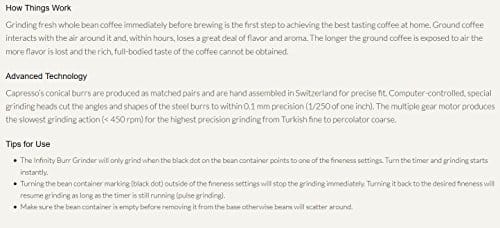


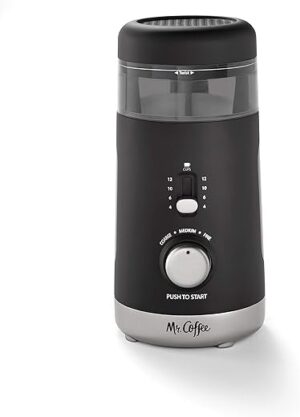

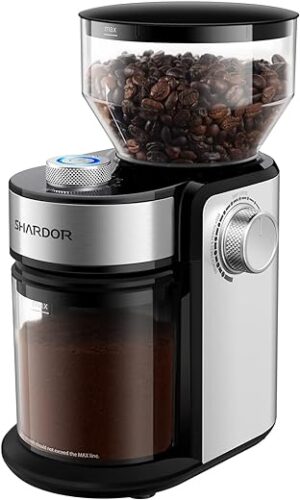

jlr –
Got my Capresso 560 in 2016 and it still works like a champ 7 years later.
Recently noticed that a small piece of the hopper that fits into the top of the grinder had chipped off, and there was some loose ‘play’ in turning the hopper before it engaged the mechanism below that regulates the size of the grind. Poking around, I found an email address for Capresso and relayed my issue, fully thinking I would probably need to buy a new unit, or shell out half that price to replace the top hopper.
The next day, I received an email from Jura, a company in New Jersey that said please call us to order this part. I did, and while it took a couple tries to get through, when I did, they said yes, we can send that to you. The cost was less than $6! I didn’t even have to pay for shipping. I was a bit gobsmacked that this level of customer service still exists.
I recommend this grinder to anyone that’s interested in a fresh ground cup in the morning. It’s reliable, durable and quiet compared to other grinders.
I’ve seen some reviews discussing static cling after the beans are ground, which yes, I have experienced. But there is a very simple solution I got from a high-end brewer off of YouTube. Just a drop or two of water on your beans will dissipate any static charge like magic. I literally dip my fingers in some water and just sprinkle a few drops over the beans before I put them in the hopper. I live in a pretty dry climate, and this works every time. Once I’m done grinding, I take the top grinder out and let the unit air dry just to make sure no residual moisture gets trapped inside.
Enjoy!
Gilbert R. –
Excellent burr grinder. Beautiful grinds for our Moka stovetop AND for our French Press when we’re in the mood.
The multiple grind choices are terrific for any changes you may want to make. The grinds are as precise as the ones we produce with our very expensive hand grinder. The device is easy to clean and just the right weight and height.
But…didn’t buy this for any of those reasons. We bought based on promised QUIET factor. Oh my gosh – LOVE the quiet purr. Our electric kettle is louder than this grinder!
Buy it. You won’t regret it.
The only quirk we notice is when removing the hopper, coffee dust drops from the grinder. It can be messy.
So, we either shake ti grinder before removing the hopper to catch the extra dust OR we open the machine and brush the burrs, etc. clear of the leftover dust.
An extra step – yes but the quietness is the guarantee we need. We got it.
jlr –
My thanks to other reviewers — whose comments regarding the wide selection of coffee mills enabled me to make the fortunate selection of the
Capresso 560 Infinity Conical Burr Grinder, Brushed Silver, 8.5-Ounce
. Having used it almost every day for several weeks, I find hardly anything negative to say about this unit (but see below), but the scope of this review does not extend to making espresso or other brews requiring special types of beans or especially fine grounds. Other reviewers have noted the major positives of theCapresso 560. For example, the motor speed is geared-down, thus slowing the speed of the rotating (lower) burr, which in turn reduces noise, reduces heating of the beans during milling, and reduces shattering of the beans and thereby gives more uniformity of the size of the grounds. As others have noted, the coarseness/fineness of the grind is easily adjusted over a very wide range, with a very high degree of control. This mill is obviously well built. It will not be the cause if you don’t get an unbeatable cup of coffee. If, as formerly I did, you use one of the blade-type coffee grinders, you may have noticed that it results in a grind with a lot of very fine particles due to bean shattering by the violent impact of the blades, and as a consequence you may have experienced, as I did, a tendency of the brewing filter on your coffee maker to become unduly clogged and even to overflow for that reason. With the Capresso burr grinder, this problem is much reduced if not eliminated (although I have yet to use the mill’s finest settings for the grind).
Now some further points. Though some of what follows might be interpreted as negative, such an interpretation really would be unjustified, since, as I try to indicate, all of the issues raised are easily nullified.
First, a basic point is just this: a little time spent in gaining familiarity with the unit’s construction and operational behavior pays off (there IS a learning curve with this unit). Just bite the bullet and spend the time required to understand the user instructions.
Second, a potential problem arises with this unit if you put the upper burr into place upside down (proper cleaning of the mill requires removal of the upper burr). Through inattention I somehow made this mistake (once) and had to resort to Capresso customer service (which had the answer with no hesitation, suggesting that it may be a more common mistake than one might have thought) to find out how to get it back out (tip: looking down on the top of the mill, notice the large, black outer ring that surrounds the burrs and use a butter knife in the obvious slot to turn the ring in a counter-clockwise direction to release the upside-down upper burr). Perhaps most people would never fall into this avoidable trap, but I mention it just in case it saved anybody from having this happen. As to cleaning the unit after milling, I have found this to be straightforward and reasonably easy.
Third, this unit has a problem with static electricity. But this is evidently the case with just about all noncommercial coffee mills — as one discovers in reading the reviews of a number of the grinders/mills offered on the Amazon site. In the case of the Capresso 560.04, and probably in the case of most any other mill, there are easy solutions to this problem, and I will now describe mine at some length.
The behavior of static electricity, even for those of us with a background in physics, can seem quite bizarre. For one thing, as one learns in studying the laws and principles of electricity in science classes, static electric charges generated internally necessarily appear instantly (and I mean VERY quickly) on the “outside” surface of an object whenever the object is completely surrounded by a nonconducting medium (note the key word “surface”) — and an equal and opposite charge will be simultaneously created on the facing surface of the external objects in the vicinity. But the outside surface of the coffee mill is altered and becomes rather complex when you move the grounds receptacle (hereafter “the cup”) from its position on the “inside” of the mill body to the “outside” or even partially to the “outside”. Moreover, when you touch the mill, you and the mill together become, as far as the static electricity is concerned, one continuous object with the total charge (which is completely harmless) distributed over your body and the mill together — excluding only the place(s) of contact between the two. Note: this short, perhaps overly simplified explanation of static electricity in the context of the mill is not intended to be beyond the possibility of any critique or amplification by professional physicists, but should suffice for the purpose at hand.
The problem of the static charge on the mill can be solved by waiting long enough for the charge to dissipate into the environment, but this can take an inconveniently long time, especially in dry air. A better solution to the problem is to carry the charge away to the general environment or directly to an earth ground via a conductor.
I implemented the latter remedy, and it works very well. One version of this remedy, easily implemented, is to use a length of wire (insulated or not) to conduct the charge to ground: with my fingers, I just hold one bare end of the grounded wire against the outside of the unit and, as I pull the cup out, I continue holding the end of the wire and bring it into contact with the “inside” surface of the cup AND the “inside” surface of the opening in the mill body itself (i.e., the opening, or docking port, where the cup fits). This discharges the whole unit (including my body), so that now the coffee grounds (i.e., those on the surface layer in the cup), which also would have become charged, are not forced (by the mutual repulsion of the charges they would have accumulated) to fly to, and distribute themselves annoyingly over, nearby surfaces.
It’s best not to get hung up on what is “inside” and what is “outside”, because the charges just follow the laws of electricity and move around extremely rapidly due to mutual repulsion/attraction to wherever these laws dictate: the instantaneous distribution and the complex movement of the charges is way beyond direct detection by human senses — although the hair on your arm may produce a sensation due to the forces arising from the attraction between the static charges on the hair and the opposite charges on external surfaces nearby. (Note that the static charge that will build up on the mill during grinding is completely harmless to a human, if it is noticeable at all.)
Still another version of the remedy, which will be described next, offers more operational convenience but involves applying some aluminum duct-sealing tape to a few places in/on the unit. The aluminum tape I refer to is adhesive-backed and is available at heating/plumbing supply stores, or at other stores like Home Depot, Lowe’s, or Ace Hardware. Just be sure you get the type of tape whose metal surface is bare and not coated with a nonconducting film. You can verify that the surface is bare metal by using a cheap ohmmeter or continuity tester.
This alternative remedy is simple and easy to implement, is very effective, does not much affect the appearance of the unit, and, as I see it, presents no undesirable results of any kind. To implement this remedy, I applied three narrow strips of the conducting tape (a quarter inch wide, say; width is not important, except for ease of handling) as shown in the two photos that I uploaded to the product page.
[For completeness, or to supplement the photos, the present paragraph describes how to apply the strips of conducting tape. Skip this paragraph if the photos are adequately informative. In what follows I will be referring to (a) the walls of the cup and (b) the walls of the docking port (i.e., the chamber in the mill body where the cup fits). First I describe the two strips of tape to be applied to the cup. One of the two strips of tape is affixed, by its own adhesive backing, to the cup so as to make a conducting path from a point at the top left of the inside of its back wall (call this point A) up and over the lip of the cup straight down to a point B at the bottom left part of its outside rear wall. The second strip starts at point B (make sure it overlaps the first strip) and runs horizontally from there along the outside wall of the cup to a point C at the bottom front corner of the left side of the cup. So much for the cup. Now I describe the third strip of tape, which will be applied to the inside of the docking port. This third strip is applied for a half inch or so along the bottom left rear wall of the docking port, and runs horizontally from there towards the front of the mill body, and finally wraps around the front corner to the outside of the mill body, leaving about a half inch of the tape exposed on the outside of the mill body. This strip is positioned in such a way that it makes contact with the other strip (the second strip as described above) — which was applied along the bottom outside of the left wall of the cup. Make sure all three strips are completely affixed with their adhesive backing along their entire length. This completes the written description of the conducting tape application, but it’s easier to understand all this by simply looking at the photos. Please note that there is a reason why I specified that the second and third strips of tape should run along the bottom of the cup and the docking port, respectively, in such a way that they can be in contact with each other continually as the cup is being pulled out of the docking port: this configuration allows no static charges to build up or persist anywhere in/on the unit while the cup is being removed.]
Having described how to apply the strips of conducting tape, I now describe how they work. I still have a grounded wire that I can momentarily touch to the small segment of tape that I left exposed on the front bottom left side of the mill’s body, as described above. This exposed segment is barely visible in one of the photos. The momentary, simultaneous contact between your fingers and the tape and the grounded wire instantly carries away all of the static charge in/on the unit, and completely eliminates the static electricity problem. But note that any subsequent rubbing of the mill’s body or the cup can build up another charge, just as rubbing a cat with a silk cloth will build up a charge. In that event, just touch the ground wire to the exposed segment of tape and your fingers simultaneously while the cup is in place in the mill body.
But wait: with the strips of conducting tape in place as described, the grounded wire may not even be necessary! Apparently, the above-described conducting path alone is sufficient to eliminate the problem of static charging of the whole device (or at least the unbalanced charge between you and the mill), although local conditions may bear on this conclusion (for example, whenever the air is very dry and the user is wearing insulated shoes and the counter/table top is highly nonconducting; under these conditions the grounded wire probably would need to be used, with the user merely needing to touch the mill and the wire simultaneously). Your own experience will lead you to your own conclusion as to whether/when you need to use the grounded wire. My experience is that merely touching the exposed segment of tape on the body of the mill (assuming all strips of tape are affixed as described above) while removing the cup completely eliminates the static charge mismatch, and thus completely solves this unit’s problem with static electricity.
Other folks may well come up with other ways (and there are many equivalent variants) to handle the static charges.
Finally, to recap, this coffee mill is terrific. I liked it so much I bought another one as a gift for my son. The only definite suggestion I could offer to Capresso to make this product all but perfect would be to design it somehow to eliminate the (unbalanced) buildup of static electricity in the first place.
For the record, I have no conflict of interest in contributing this review. I hope readers find it worthwhile, and comments would be welcome.
[Note (13 February 2013): thanks to a reader who kindly provided me a tip on uploading the two photos I mentioned in the review. These photos can be accessed from the product page.]
luis c. –
Ive had this grinder for about 2 months now as I hate to review anything within the first few weeks of getting it. Ill say that I’m not a complete Coffee snob, but I do like good coffee at home.
I recently got a Rancillio Silvia machine and quickly discovered that my regular “blade grinder” was nowhere up to the task of producing the consistent fine grinds that i needed for the Silvia.
Lots of research and questions ensued and I settled on the Capresso Infinity based on the value/size/grind consistency etc. So far I’m very happy with the results and have a few notes for anyone thinking about this purchase.
1. Not all coffee machines are equal (goes without saying) but you will need to find out what size grind your machine works best with. The Capresso has 16 different grind sizes and the Silvia likes Extra Fine grinds. If 1 is the smallest (think talcum powder) then I use 3 or 4 (see note 2).
2. Not all coffee beans are equal. I’ve found that some store bought beans (Lavazza) are drier (less oily) than freshly roasted beans. In my expermenting, I’ve found that Grind setting 3 works better for the “drier beans” while Grind setting 4 works better for the wetter or oilier beans. Note: that is based on my humid climate as well. Others may have different results to me.
All in all, I’m very happy with my purchase and hope it lasts for at least a couple of years!
Good luck and great coffee to all.
Joseph Rodriguez –
We have been using this grinder for the past 4 years; figure approximately 500 cycles of grinding coffee beans. As many reviewers stated, there was a real issue in the very beginning regarding static electricity. The issue simply resolved by itself after maybe 3 months of using the grinder. The consistency of the grinding is above my expectations after this period of time. I just had to raise my usual setting lately by 2 notches to compensate the wear of the burr grinding mechanism. I still have some adjustments left. This grinder will need frequent cleaning. I clean it every 2 months. It’s really easy to remove the basket and access the grinding burrs. No tools are required. My trick for fast easy cleaning: USE SOME COMPRESSED AIR! It does the job super fast without the need of a brush. (Make this mess outside please!) This grinder goes along with a Breville BES840XL. I believe it’s a perfect match considering the value of our espresso machine. I know some of my coworkers with high-end espresso machines (2000$+) are politely denying this grinder.
*One design flaw: the lower receptacle is not big enough to accomodate a full upper basket of grinded coffee beans. You have to make it a 2 steps operation everytime or insert only in the upper basket an half load of coffee beans. Also, there is no graduation on either basket and receptacle. One will have to make it’s own experiment regarding the quantities.
I would consider buying the exact same grinder if this one ever fails.
*UPDATE oct22; We grinded some coarse coffee for a guest at home. He prefers filtered coffee. We used the same bag of beans. The static electricity problem came back right away! So i can positively say now that the problem will occur more often using a coarse grinding.
Adjo –
Me gusto mucho. Solo que lamentablemente extravie esa pieza. ¿Hay forma de adquirirla ?
TorontoPete –
UPDATE 2: Going into the 4th year of using this grinder and have found that a thorough cleaning of the grinding burrs and components about once every 2 months is a good idea. Grounds get trapped under lower burr assembly and pack there. Some tips on disassembly:Figured out how to release the upper burr from the cup(two little moulded in clips that need to be CAREFULLY pried back to release the metal burr). The full cleaning has probably helped with the longevity. The long screw that holds the lower burr assembly in place is a #20 Torx head. Once you lift the assembly off the 3 ball bearings and springs will slide out of the bottom and can get lost.On reassembly the ball bearings go into the holes in the assembly first,then the springs…turning the whole grinder on it’s side helps with sliding the assembly back into place without the springs and bearings falling out. Update: Been using this unit daily for over 6 months now with no issues.. I brew at least 1 pot of drip coffee per day and once I got the grind size set it remains consistent.No real issues with static even though the grounds container is plastic. Once the grinding is finished I found that tapping lightly on the removable container a couple of times gets the last of the grounds out of the chute so they don’t fall onto the base when you take the container out. As far as cleaning goes..get a better brush than the included one (too soft!). I found a stiff bristled toothbrush worked well. It is difficult to clean out under the conical burr with a brush so I used a couple of shots of keyboard duster (worked well but I did this out on my deck so I didn’t get coffee dust all over the kitchen!!), then just wiped everything out with a damp cloth. Quite happy with this unit, don’t know about it’s longevity but so far no issues.
luis c. –
Bought this after reading a review that stated it was one of the the best in performance and the quietest of the tested models. It is certainly quiet – yes, it still makes a noise, somewhat louder than our dishwasher, but quiet enough I no longer worry about waking the rest of the family when I grind my morning coffee.
I only wish it came with some preset timers rather than a dial that one turns and hopes it stops at the correct number. In my case, I am grinding beans for one 16oz cup of coffee. To get the correct quantity, I need to turn the dial to “2”. Well, if I mess up and stop at 1.7 or 2.2, I either get too little or too much. And that’s quite easy to do. Wouldn’t be as serious an issue if I was grinding more at a time, since a difference of 0.2 is relatively minor the more you grind.
Other than that, I love this grinder. As does the rest of the family who can finally sleep through my morning grind.
JP –
Very Quiet, efficient and it doesn’t overheat. Best part is the price. A lot if not most of the decent coffee grinders are very expensive because the way the coffee is grounded has a big effect on the taste of your coffee. So some people do splurge so they get the best tasting coffee.
Although for people that has low budget, I had to literally research so many reviews and try the brands one by one. Because one can’t rely on a five star review anymore. Sometimes, they’re a dime a dozen. No offense to the ones that give their honest review.
Anyhow, the Capreso is the third grinder I tried in a year span. As you can tell the two previous brands didn’t last, it overheats so it stops while im grinding . Also, I had to wait for it to cool down so I can continue grinding. I just use the grinders for home use not commercial . Finally , the previous brands were loud. I had to use a set of ear plugs while I’m using it.